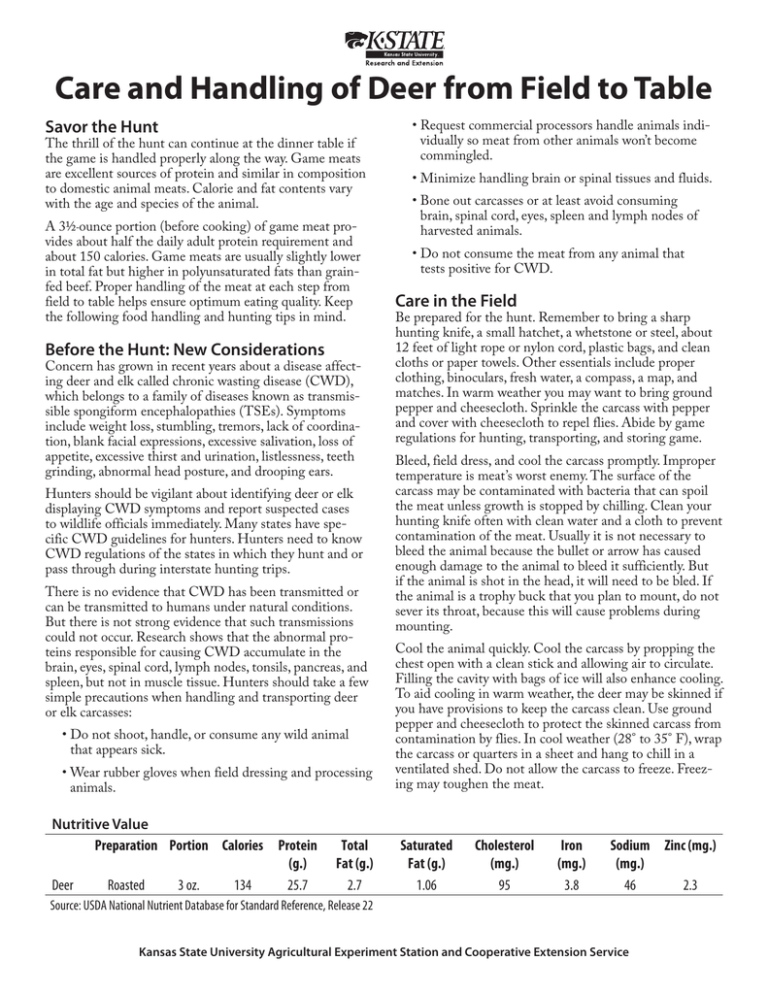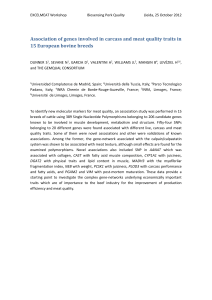
P
R
E
S
E
R
V
I
N
G
Care and Handling of Deer from Field to Table
Savor the Hunt
The thrill of the hunt can continue at the dinner table if
the game is handled properly along the way. Game meats
are excellent sources of protein and similar in composition
to domestic animal meats. Calorie and fat contents vary
with the age and species of the animal.
A 31/2-ounce portion (before cooking) of game meat provides about half the daily adult protein requirement and
about 150 calories. Game meats are usually slightly lower
in total fat but higher in polyunsaturated fats than grainfed beef. Proper handling of the meat at each step from
field to table helps ensure optimum eating quality. Keep
the following food handling and hunting tips in mind.
Before the Hunt: New Considerations
Concern has grown in recent years about a disease affecting deer and elk called chronic wasting disease (CWD),
which belongs to a family of diseases known as transmissible spongiform encephalopathies (TSEs). Symptoms
include weight loss, stumbling, tremors, lack of coordination, blank facial expressions, excessive salivation, loss of
appetite, excessive thirst and urination, listlessness, teeth
grinding, abnormal head posture, and drooping ears.
Hunters should be vigilant about identifying deer or elk
displaying CWD symptoms and report suspected cases
to wildlife officials immediately. Many states have specific CWD guidelines for hunters. Hunters need to know
CWD regulations of the states in which they hunt and or
pass through during interstate hunting trips.
There is no evidence that CWD has been transmitted or
can be transmitted to humans under natural conditions.
But there is not strong evidence that such transmissions
could not occur. Research shows that the abnormal proteins responsible for causing CWD accumulate in the
brain, eyes, spinal cord, lymph nodes, tonsils, pancreas, and
spleen, but not in muscle tissue. Hunters should take a few
simple precautions when handling and transporting deer
or elk carcasses:
• Do not shoot, handle, or consume any wild animal
that appears sick.
• Wear rubber gloves when field dressing and processing
animals.
Nutritive Value
Preparation Portion Calories Protein
(g.)
Deer
Roasted
3 oz.
134
25.7
Total
Fat (g.)
2.7
• Request commercial processors handle animals individually so meat from other animals won’t become
commingled.
• Minimize handling brain or spinal tissues and fluids.
• Bone out carcasses or at least avoid consuming
brain, spinal cord, eyes, spleen and lymph nodes of
harvested animals.
• Do not consume the meat from any animal that
tests positive for CWD.
Care in the Field
Be prepared for the hunt. Remember to bring a sharp
hunting knife, a small hatchet, a whetstone or steel, about
12 feet of light rope or nylon cord, plastic bags, and clean
cloths or paper towels. Other essentials include proper
clothing, binoculars, fresh water, a compass, a map, and
matches. In warm weather you may want to bring ground
pepper and cheesecloth. Sprinkle the carcass with pepper
and cover with cheesecloth to repel flies. Abide by game
regulations for hunting, transporting, and storing game.
Bleed, field dress, and cool the carcass promptly. Improper
temperature is meat’s worst enemy. The surface of the
carcass may be contaminated with bacteria that can spoil
the meat unless growth is stopped by chilling. Clean your
hunting knife often with clean water and a cloth to prevent
contamination of the meat. Usually it is not necessary to
bleed the animal because the bullet or arrow has caused
enough damage to the animal to bleed it sufficiently. But
if the animal is shot in the head, it will need to be bled. If
the animal is a trophy buck that you plan to mount, do not
sever its throat, because this will cause problems during
mounting.
Cool the animal quickly. Cool the carcass by propping the
chest open with a clean stick and allowing air to circulate.
Filling the cavity with bags of ice will also enhance cooling.
To aid cooling in warm weather, the deer may be skinned if
you have provisions to keep the carcass clean. Use ground
pepper and cheesecloth to protect the skinned carcass from
contamination by flies. In cool weather (28° to 35° F), wrap
the carcass or quarters in a sheet and hang to chill in a
ventilated shed. Do not allow the carcass to freeze. Freezing may toughen the meat.
Saturated
Fat (g.)
1.06
Cholesterol
(mg.)
95
Iron
(mg.)
3.8
Sodium Zinc (mg.)
(mg.)
46
2.3
Source: USDA National Nutrient Database for Standard Reference, Release 22
Kansas State University Agricultural Experiment Station and Cooperative Extension Service
Keep the carcass clean. Remove all foreign particles and
loose hair. Remove bloodshot areas.Wipe out excess blood
in gutted cavity with a paper towel or clean cloth and clean
water. Use as little water a possible, because damp meat
spoils faster than dry meat. Do not use grass or snow to
wipe out the carcass because this may contaminate it.
carcasses with little or no fat covering. They may dry out
during aging. Leave the hide on and maintain the proper
temperature when aging a carcass. If you do not have the
proper cooler space, spoilage or dehydration may result.
Aging the carcass two to three days is sufficient. If you
intend to grind the meat into sausage, aging is unnecessary.
Field Dressing
Care in the Kitchen
Wear plastic surgical gloves during field dressing.
1. Place the animal on its back with the front end
elevated and spread the hind legs. Support the carcass
in position by placing rocks or sticks on each side.
2. Cut along the midline of the belly from the breastbone to the anus. Avoid cutting into the paunch and
intestines by using the handle of the knife and the
heel of your hand to crowd the guts away. Cut around
the anus, loosening the bung so it will come out with
the guts.
3. Cut the diaphragm (the thin sheet of muscle and
connective tissue between the chest and the abdomen) free from the rib cage by cutting through the
white tissue near the rib cage.
4. Reach forward to cut the windpipe, gullet, and blood
vessels at the base of the throat.
5. Pull the lungs, heart, and guts out of the animal. If
you like variety meats, save the heart and liver in a
plastic bag and put on ice.
Care in Transport and Processing
Keep the carcass cool during transport. Do not tie a deer
carcass across the hood of the car or put it in the trunk
when the animal is still warm. The game may be processed
commercially or at home. Be sure to keep the carcass cool
until it reaches the locker plant. Keep the carcass out of
direct sunlight and allow for adequate air circulation.
If you choose to process your own game, don’t cross-contaminate during processing. Wash your knife, hands, and
cutting board often with warm soapy water.
Aging meat is the practice of holding carcasses or cuts
of meat at temperatures of 34° to 37° F for 10 to 14 days
to allow the enzymes in the meat to break down some of
the complex proteins in the carcass. Aged meat is often
more tender and flavorful. Aging is not recommended for
For immediate use, store the meat in the refrigerator and
use within two or three days. Keep raw meat and cooked
meat separate to prevent cross-contamination.
Freeze game properly. Prevent “freezer burn” by using the
right packaging materials. Divide meat into meal-size
quantities. Use moisture/vapor-proof wrap such as heavily
waxed freezer wrap, laminated freezer wrap, heavy-duty
aluminum foil or freezer-weight polyethylene bags. Press
the air out of the packages before sealing. Label the packages with the contents and date. Avoid overloading the
freezer. Freeze only the amount that will become solidly
frozen within 24 hours. Game will keep nine to 12 months
in the freezer if properly wrapped.
Do not can the meat unless you have a pressure canner.
Low-acid foods, such as meat and most mixtures of foods,
should never be canned using the water bath method.
Pressure and adequate time are necessary to produce safe
canned meat. For the latest canning information, contact
your local K-State Research and Extension office.
Thaw frozen meat in the refrigerator or microwave oven.
Cook game meats thoroughly. Foods thawed in the microwave oven should be cooked immediately. Refrigeratorthawed meat should be used within one to two days.
Game meats should be cooked to at least 165° F to reduce
the risk of foodborne illness. Big game animals usually
exercise more than domestic animals, so game meats may
be drier and less tender. Moist heat methods, such as braising (simmering in a small amount of liquid in a covered
pot), may result in a better product. Chops and steaks may
be pan fried or broiled.
The distinctive flavor of game meats is mainly due to the
fat they contain. To reduce the gamey flavor, trim the fat
from the meat. You may wish to add other sources of fat
to maintain the juiciness of the meat. Spices or marinades
may be used to mask the gamey flavor. Meat should always
be marinated in the refrigerator.
Revised by Karen Blakeslee, M.S., Extension Associate, Food Science
Adapted from From Field to Table: A Pocket Guide for the Care and Handling of Deer and Elk by Julie Garden-Robinson, Food and Nutrition Specialist, North Dakota State University Extension, and
Martin Marchello, Professor, Department of Animal and Range Sciences, North Dakota State University, July 2003. Revised with permission by Karen Blakeslee, Extension Associate, Food Science,
Kansas State University, November 2010.
Brand names appearing in this publication are for product identification purposes only. No endorsement is intended, nor is criticism implied of similar products not mentioned.
Publications from Kansas State University are available on the World Wide Web at: www.ksre.ksu.edu
Publications are reviewed or revised annually by appropriate faculty to reflect current research and practice. Date shown is that of publication or last revision. Contents of thispublication may be freely
reproduced for educational purposes. All other rights reserved. In each case, credit Karen Blakeslee, Care and Handling of Deer from Field to Table, Kansas State University, November 2010.
Kansas State University Agricultural Experiment Station and Cooperative Extension Service
MF-2176
November 2010
K-State Research and Extension is an equal opportunity provider and employer. Issued in furtherance of Cooperative Extension Work, Acts of May 8 and June 30, 1914, as
amended. Kansas State University, County Extension Councils, Extension Districts, and United States Department of Agriculture Cooperating, Gary Pierzynski, Interim Director.




